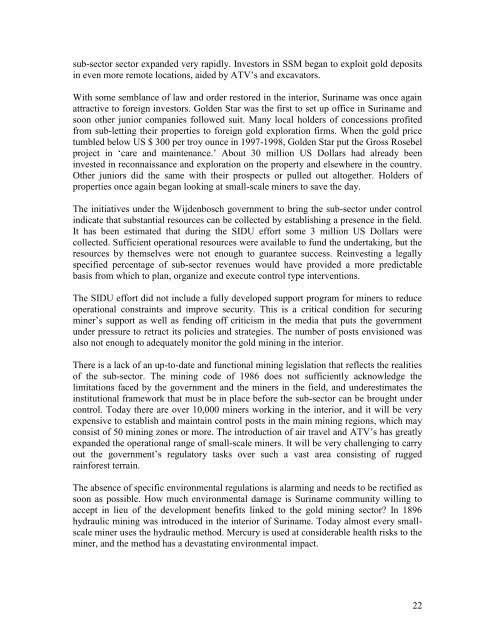SITUATION ANALYSIS OF THE SMALL-SCALE GOLD ... - WWF
SITUATION ANALYSIS OF THE SMALL-SCALE GOLD ... - WWF
SITUATION ANALYSIS OF THE SMALL-SCALE GOLD ... - WWF
Create successful ePaper yourself
Turn your PDF publications into a flip-book with our unique Google optimized e-Paper software.
sub-sector sector expanded very rapidly. Investors in SSM began to exploit gold deposits<br />
in even more remote locations, aided by ATV‟s and excavators.<br />
With some semblance of law and order restored in the interior, Suriname was once again<br />
attractive to foreign investors. Golden Star was the first to set up office in Suriname and<br />
soon other junior companies followed suit. Many local holders of concessions profited<br />
from sub-letting their properties to foreign gold exploration firms. When the gold price<br />
tumbled below US $ 300 per troy ounce in 1997-1998, Golden Star put the Gross Rosebel<br />
project in „care and maintenance.‟ About 30 million US Dollars had already been<br />
invested in reconnaissance and exploration on the property and elsewhere in the country.<br />
Other juniors did the same with their prospects or pulled out altogether. Holders of<br />
properties once again began looking at small-scale miners to save the day.<br />
The initiatives under the Wijdenbosch government to bring the sub-sector under control<br />
indicate that substantial resources can be collected by establishing a presence in the field.<br />
It has been estimated that during the SIDU effort some 3 million US Dollars were<br />
collected. Sufficient operational resources were available to fund the undertaking, but the<br />
resources by themselves were not enough to guarantee success. Reinvesting a legally<br />
specified percentage of sub-sector revenues would have provided a more predictable<br />
basis from which to plan, organize and execute control type interventions.<br />
The SIDU effort did not include a fully developed support program for miners to reduce<br />
operational constraints and improve security. This is a critical condition for securing<br />
miner‟s support as well as fending off criticism in the media that puts the government<br />
under pressure to retract its policies and strategies. The number of posts envisioned was<br />
also not enough to adequately monitor the gold mining in the interior.<br />
There is a lack of an up-to-date and functional mining legislation that reflects the realities<br />
of the sub-sector. The mining code of 1986 does not sufficiently acknowledge the<br />
limitations faced by the government and the miners in the field, and underestimates the<br />
institutional framework that must be in place before the sub-sector can be brought under<br />
control. Today there are over 10,000 miners working in the interior, and it will be very<br />
expensive to establish and maintain control posts in the main mining regions, which may<br />
consist of 50 mining zones or more. The introduction of air travel and ATV‟s has greatly<br />
expanded the operational range of small-scale miners. It will be very challenging to carry<br />
out the government‟s regulatory tasks over such a vast area consisting of rugged<br />
rainforest terrain.<br />
The absence of specific environmental regulations is alarming and needs to be rectified as<br />
soon as possible. How much environmental damage is Suriname community willing to<br />
accept in lieu of the development benefits linked to the gold mining sector? In 1896<br />
hydraulic mining was introduced in the interior of Suriname. Today almost every smallscale<br />
miner uses the hydraulic method. Mercury is used at considerable health risks to the<br />
miner, and the method has a devastating environmental impact.<br />
22
















